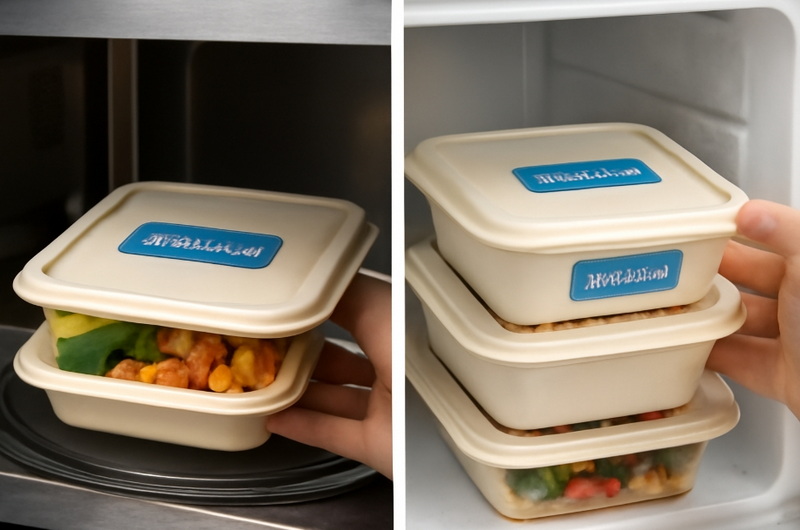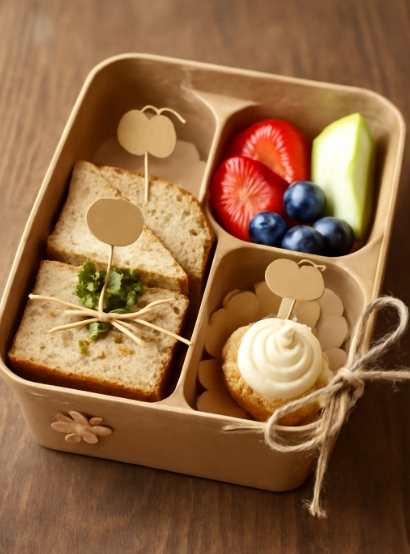
Content Menu
● Understanding Disposable Boxes With Lids
>> Common Materials Used in Disposable Boxes With Lids
● Are Disposable Boxes With Lids Microwave Safe?
>> Key Factors for Microwave Safety
>>> What Makes a Disposable Box With Lid Microwave Safe?
>>> Risks of Using Non-Microwave Safe Containers
>> Best Practices for Microwaving Disposable Boxes With Lids
● Are Disposable Boxes With Lids Freezer Safe?
>> Key Factors for Freezer Safety
>>> What Makes a Disposable Box With Lid Freezer Safe?
>>> Risks of Using Non-Freezer Safe Containers
>> Best Practices for Freezing Food in Disposable Boxes With Lids
● Advantages of Using Disposable Boxes With Lids for Microwave and Freezer
● Limitations and Safety Considerations
● How to Choose the Right Disposable Box With Lid
● Tips for Safe Use of Disposable Boxes With Lids
● Conclusion
● FAQ
>> 1. Are all disposable boxes with lids microwave safe?
>> 2. Can I freeze food in any disposable box with lid?
>> 3. Should I remove the lid when microwaving food in a disposable box?
>> 4. How can I tell if a disposable box with lid is safe for microwave or freezer?
>> 5. Is it safe to reuse disposable boxes with lids for microwaving or freezing?
When it comes to food storage, convenience, and hygiene, the disposable box with lid has become an indispensable item in modern kitchens, restaurants, and food delivery services. These containers offer a practical solution for storing leftovers, meal prepping, and transporting food. However, a common question arises: Is a disposable box with lid microwave and freezer safe? This comprehensive guide will explore the materials, safety considerations, best practices, and common questions related to using disposable boxes with lids in microwaves and freezers.

Understanding Disposable Boxes With Lids
A disposable box with lid is designed for single or limited use, offering a convenient way to store and transport food. These containers come in various shapes and sizes, and are typically made from different types of plastics or biodegradable materials. The lid serves to keep food fresh, prevent spills, and maintain hygiene.
Common Materials Used in Disposable Boxes With Lids
The safety and suitability of a disposable box with lid for microwave or freezer use depends largely on the material from which it is made. The most common materials include:
- Polypropylene (PP): This is a popular choice for microwave-safe containers due to its high heat resistance. Polypropylene can withstand typical microwave temperatures without melting or deforming.
- High-Density Polyethylene (HDPE): Known for its durability at low temperatures, HDPE is often used for freezer-safe containers. It resists cracking and maintains integrity in freezing conditions.
- Polystyrene (PS) and Polyvinyl Chloride (PVC): These plastics are less commonly microwave safe and may release harmful chemicals when heated. They are generally not recommended for microwave use.
- Bagasse (Sugarcane Fiber): This biodegradable material is increasingly used for eco-friendly disposable boxes with lids. It is suitable for both freezing and moderate heating, but may not be ideal for high-temperature microwaving.
- Paperboard with Coatings: Some disposable boxes with lids are made from paperboard lined with a thin plastic or wax coating. These are usually suitable for cold storage but may not be safe for microwaving unless specifically labeled as such.
Understanding the material of your disposable box with lid is crucial for safe use in both microwaves and freezers.
Are Disposable Boxes With Lids Microwave Safe?
Key Factors for Microwave Safety
Not every disposable box with lid is microwave safe. Microwave-safe containers are engineered to withstand the heat generated inside a microwave oven without melting, warping, or leaching harmful chemicals into your food.
What Makes a Disposable Box With Lid Microwave Safe?
- Heat Resistance: The material must tolerate microwave temperatures without deforming or breaking down. Polypropylene is commonly used for this reason.
- Labeling: Many microwave-safe disposable boxes with lids feature a microwave symbol or specific instructions indicating their suitability for microwave use.
- Design: Some lids are vented or designed to be slightly opened during microwaving to prevent pressure buildup and potential accidents.
- Chemical Safety: Containers that are BPA-free are preferred, as BPA (bisphenol A) can migrate into food when heated and has been linked to health concerns.
Risks of Using Non-Microwave Safe Containers
Using a disposable box with lid that is not microwave safe can result in:
- Melting or warping of the container, leading to spills and messes.
- Release of harmful chemicals into your food, which can pose health risks.
- Potential fires or damage to your microwave oven.
Best Practices for Microwaving Disposable Boxes With Lids
To ensure safe and effective use of a disposable box with lid in the microwave:
- Check for Microwave-Safe Labeling: Always look for a microwave-safe symbol or wording on the container or packaging.
- Remove or Loosen the Lid: Before microwaving, remove the lid or at least loosen it to allow steam to escape. This prevents pressure buildup that could cause the lid to pop off or the container to deform.
- Avoid Overheating: Do not microwave food for extended periods in disposable boxes, as excessive heat can degrade the plastic and increase the risk of chemical leaching.
- Monitor for Damage: Discard any disposable box with lid that shows signs of warping, cracking, or discoloration after use.
- Be Cautious with Oily Foods: Oil and fat can reach higher temperatures than water in the microwave, which may cause some plastics to break down more quickly.
By following these guidelines, you can safely use a disposable box with lid for reheating food in the microwave.
Are Disposable Boxes With Lids Freezer Safe?
Key Factors for Freezer Safety
Freezer-safe disposable boxes with lids are designed to withstand the low temperatures of a freezer without becoming brittle, cracking, or allowing air and moisture to seep in, which can cause freezer burn.
What Makes a Disposable Box With Lid Freezer Safe?
- Material Flexibility: Materials like high-density polyethylene and polypropylene remain flexible and durable at freezing temperatures, reducing the risk of cracking.
- Seal Quality: A tight-fitting lid is essential to keep out air and moisture, which can lead to freezer burn and food spoilage.
- Thickness and Durability: Thicker-walled containers are less likely to become brittle or break in the freezer.
Risks of Using Non-Freezer Safe Containers
Using the wrong type of disposable box with lid in the freezer can result in:
- Cracking or shattering of the container, leading to spills and potential contamination.
- Loss of food quality due to freezer burn or exposure to air.
- Difficulty in removing the container from the freezer without damage.
Best Practices for Freezing Food in Disposable Boxes With Lids
To ensure safe and effective use of a disposable box with lid in the freezer:
- Use Freezer-Safe Containers: Only use containers specifically labeled as freezer safe.
- Seal Properly: Make sure the lid is securely fastened to prevent air and moisture from entering.
- Avoid Overfilling: Leave some space at the top of the container for food expansion as it freezes.
- Label and Date: Clearly label the contents and date of freezing to keep track of food freshness.
- Avoid Refreezing: Do not refreeze food that has already been thawed, as this can compromise safety and quality.
By following these tips, you can safely use a disposable box with lid for storing food in the freezer.

Advantages of Using Disposable Boxes With Lids for Microwave and Freezer
Disposable boxes with lids offer several benefits for both microwave and freezer use:
- Convenience: They eliminate the need for washing and are ideal for busy lifestyles.
- Hygiene: Single-use containers reduce the risk of cross-contamination and foodborne illnesses.
- Portability: Secure lids make these containers perfect for transporting food without spills.
- Versatility: Suitable for a wide range of foods, from soups to salads to main courses.
- Space Efficiency: Stackable designs help maximize storage space in both refrigerators and freezers.
- Cost-Effectiveness: Bulk purchasing of disposable boxes with lids is often more economical for businesses and large families.
Limitations and Safety Considerations
Despite their advantages, disposable boxes with lids have some limitations and important safety considerations:
- Single Use: Most are designed for one-time use. Reusing them, especially for reheating, can increase the risk of chemical migration and structural failure.
- Material Variability: Not all disposable boxes with lids are created equal. Always check for microwave or freezer-safe labeling.
- Environmental Impact: Single-use plastics contribute to environmental pollution. Consider biodegradable or compostable options when possible.
- Not for High-Temperature Cooking: Avoid using disposable boxes with lids for baking, broiling, or stovetop cooking.
- Potential for Chemical Leaching: Only use BPA-free and food-grade containers to minimize health risks.
How to Choose the Right Disposable Box With Lid
Selecting the appropriate disposable box with lid for your needs involves considering several factors:
- Intended Use: Determine whether you need the container for microwaving, freezing, or both.
- Material: Choose polypropylene for microwaving and polyethylene or bagasse for freezing.
- Size and Shape: Select a size that matches your food portion and storage space.
- Seal Quality: Ensure the lid fits tightly to prevent leaks and contamination.
- Eco-Friendliness: Opt for biodegradable or compostable options if environmental impact is a concern.
By paying attention to these factors, you can select the most suitable disposable box with lid for your food storage and reheating needs.
Tips for Safe Use of Disposable Boxes With Lids
- Always read the manufacturer's instructions and labels.
- Do not use containers that are damaged or show signs of wear.
- Never use a disposable box with lid in the oven or on the stovetop.
- Avoid microwaving foods with high fat or sugar content for long periods.
- Dispose of containers properly after use, especially if they are not intended for reuse.
Conclusion
A disposable box with lid can be both microwave and freezer safe, provided it is made from the right materials and used according to the manufacturer's guidelines. Polypropylene containers are generally safe for microwaving, while polyethylene and bagasse options are suitable for freezing. Always check for specific labeling, use lids appropriately, and avoid exposing containers to extreme temperatures beyond their design. By following best practices, you can enjoy the convenience and safety of disposable boxes with lids for all your food storage, reheating, and transport needs.

FAQ
1. Are all disposable boxes with lids microwave safe?
No, only those made from microwave-safe materials like polypropylene and labeled as such should be used in the microwave. Others may melt or release harmful chemicals.
2. Can I freeze food in any disposable box with lid?
No, only boxes designed for freezer use, typically made from polyethylene, polypropylene, or bagasse, should be used to prevent cracking and freezer burn.
3. Should I remove the lid when microwaving food in a disposable box?
It is recommended to remove or at least loosen the lid to allow steam to escape and prevent pressure buildup, which can cause the container to deform or the lid to pop off.
4. How can I tell if a disposable box with lid is safe for microwave or freezer?
Look for symbols or labels indicating microwave or freezer safety. Manufacturer instructions and material codes (such as PP for microwave-safe) are also helpful indicators.
5. Is it safe to reuse disposable boxes with lids for microwaving or freezing?
Generally, disposable boxes are intended for single use. Reusing them, especially for heating, can increase the risk of chemical leaching and container degradation.

















